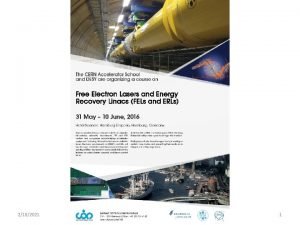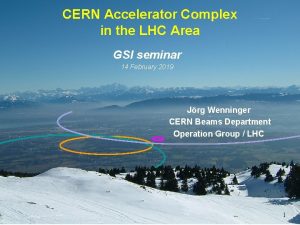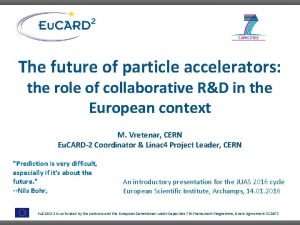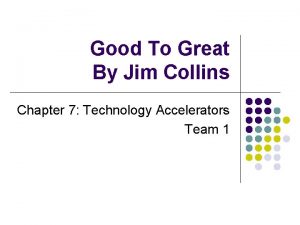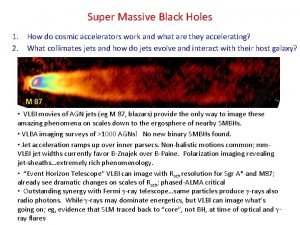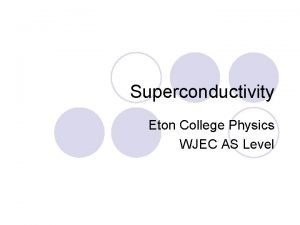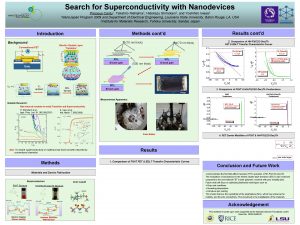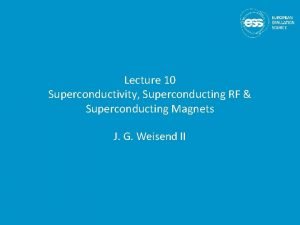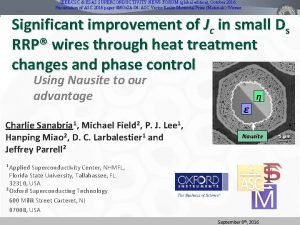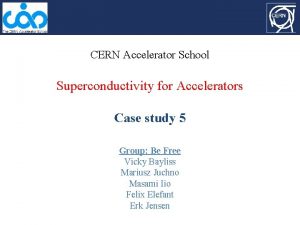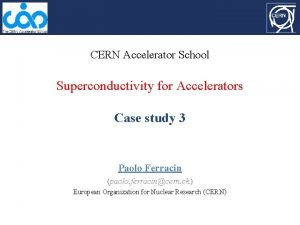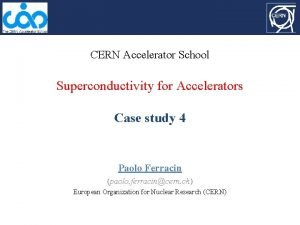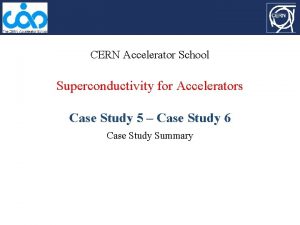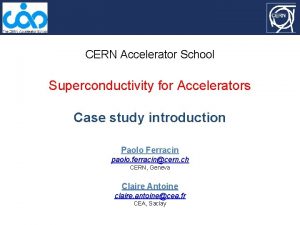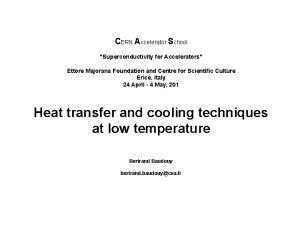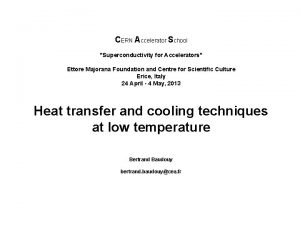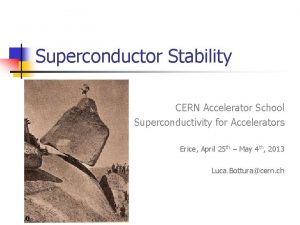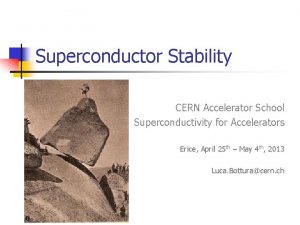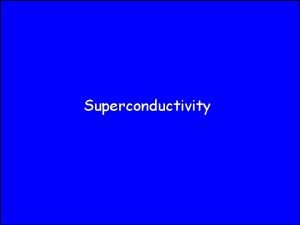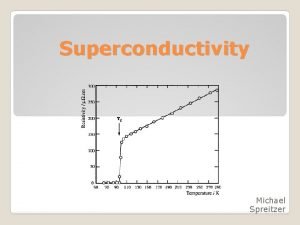CASE 6 CERN Accelerator School Superconductivity for Accelerators













- Slides: 13

CASE 6 CERN Accelerator School Superconductivity for Accelerators Case study 6: RF test and properties of a superconducting cavity GROUP B C. Darve S. Izquierdo Bermudez X. Niu K. Papke R. Santiago Kern

Elliptical 5 -cell cavity in pi-mode: Basic Parameters (I) CASE 6 1. Energy of the protons: 2. Distance between two neighbouring cells (L) and length of the cavity (Lacc) Superconductivity for Accelerators, Erice, Italy, 25 April - 4 May, 2013 Case study 6 2

Elliptical 5 -cell cavity in pi-mode: Basic Parameters (II) CASE 6 3. All the given parameters depend ONLY in the geometry of the cavity Remark 1: Typically, for elliptical cells β=[0. 6, 0. 8] and Epk/Eacc=[2, 2. 6] Cavities with elliptical cells for low beta become very big as lower frequencies are used and less stable mechanically (the accelerating gap shortens and cavity walls become more vertical) Remark 2: In circular accelerators the factor Ra/Q is usually defined as: Superconductivity for Accelerators, Erice, Italy, 25 April - 4 May, 2013 Case study introduction 3

RBCS CASE 6 10000 f=704. 4 MHz Tc(Nb)=9. 2 K T 4. 3 4 3 2 Rbcs [nΩ] 1000 100 4. 3 K 10 Rbcs [nΩ] 168. 4 133. 0 40. 7 3. 2 1 1 2 2 3 3 4 Tc/T [1/K] 4 5 2 K 5 Superconductivity for Accelerators, Erice, Italy, 25 April - 4 May, 2013 Case study introduction 4

Quality Factor Qo CASE 6 For a real cavity, the residual resistance should be taken into account. The possible contributions to Rres: • • • Trapped magnetic field Normal conducting precipitates Grain boundaries Interface losses Subgap states RRR? Superconductivity for Accelerators, Erice, Italy, 25 April - 4 May, 2013 Case study introduction 5

Accelerating and maximum gradient (I) CASE 6 6. Operation @ stored energy of 65 J i) Accelerating gradient ii) Dissipated power in the cavity walls Expected location of the Magnetic quench Superconductivity for Accelerators, Erice, Italy, 25 April - 4 May, 2013 Magnetic field 7. Maximum gradient that can be achieved in this cavity If we take 190 m. T as the critical magnetic RF surface field at 2 K z Case study introduction 6

Accelerating and maximum gradient (II) CASE 6 Eacc (14. 2 MV/m) < Emax (34 MV/m) • We are operating at half of the maximum accelerating gradient. Is this standard? • Of course, we don’t wont to work at Emax any perturbation in the system will involve a quench: Heat source Pdis ∆T Possible sources: • Surface defects • Bad cooling • Multipacting • Field emission Superconductivity for Accelerators, Erice, Italy, 25 April - 4 May, 2013 Cooling power is able to compensate: nothing happens Magnetic quench Case study introduction 7

Loaded Quality Factor QL CASE 6 QL Δω We will be able to tune the cavity within this range Superconductivity for Accelerators, Erice, Italy, 25 April - 4 May, 2013 Case study introduction 8

Tuners CASE 6 FREQUENCY TUNERS: Keep the frequency of the cavity on its nominal value. 1. Stepper motor tuners: for coarse tuning, they are slow in response (i. e. when the cavity is cooled down) 2. Piezo-tuners: for fine tuning, fast response (i. e. to accommodate for vibrations and pressure fluctuations from the He bath). The control of the piezo tuners is done by comparing the phase difference between reflected and forward signals H. Saugnac SLHi. PP 2 Superconductivity for Accelerators, Erice, Italy, 25 April - 4 May, 2013 Case study introduction 9

Impact of a normal conducting incursion defect (piece of copper) CASE 6 Especially in high magnetic field regions, defects lead to high energy dissipation Critical magnetic RF surface field • Local Surface resistant at the defects much higher Defects of 1µm already have an impact! • Mean surface resistance Rs (averaged over the surface) increased R over Q • The impact will be different depending in the location! Superconductivity for Accelerators, Erice, Italy, 25 April - 4 May, 2013 Case study 6 10

Additional questions (I) CASE 6 Let’s assume that we are thinking about a high field accelerator quality magnet High temperature superconductor: YBCO vs. Bi 2212: • We can produce round wires with multifilamentary configuration • Mechanically instability is still an issue No significant differences in terms of critical surface/penetration depth in between Bi 2212/YBCO: • Seems very promising, lower cost? • But… • Strongly anisotropic • Nowadays only available in tapes and lot of open questions • Effect of transverse stress? • AC losses/ transient effects on field quality Our choice: Bi 2212 Superconductivity for Accelerators, Erice, Italy, 25 April - 4 May, 2013 Case study 6 11

Additional questions (II) CASE 6 Superconducting coil design: block vs. cos Use the beam pipe as inner support More flexibility: dipole, quadrupole, sextupole… Ratio central field/current density is more with the same quantity of cable. Block Easier to wind For the case of a dipole, simple way to achieve good field quality. . . but mechanical support can be an issue Our choice: cos Support structures: collar-based vs. shell-based If the field is very high, you need higher pre-stress after cool down…so the bladders/shell-based solution should be better. Still lot of development needed to assure mechanical stability at 20 T! Our choice: shell-based

Additional questions (III) Assembly procedure: high pre-stress vs. low pre-stress • • • We always want to apply sufficient pre-stress to assure that all the cables are under compression in operation conditions. During the R&D phase, one should look at maximum pre-stress can be applied before degradation and stays bellow this value. For production, to assure reproducibility, one should keep some margin (about 20%-40%) from this upper boundary. If the pre-stress is very low, reproducibility might become an issue? CASE 6
 Cern accelerator school 2021
Cern accelerator school 2021 Cern accelerator complex
Cern accelerator complex The long-term future of particle accelerators
The long-term future of particle accelerators Accelerators computer architecture
Accelerators computer architecture Kotter 8 accelerators
Kotter 8 accelerators Good to great technology accelerators
Good to great technology accelerators Good to great chapter 7
Good to great chapter 7 Cosmic super accelerators
Cosmic super accelerators Set current query acceleration
Set current query acceleration Superconductivity a level physics
Superconductivity a level physics Superconductivity
Superconductivity Superconductivity
Superconductivity Superconductivity
Superconductivity Superconductivity
Superconductivity
